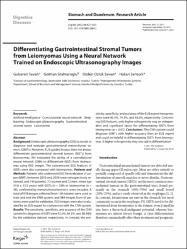| dc.contributor.author | Seven, Gülseren | |
| dc.contributor.author | Silahtaroğlu, Gökhan | |
| dc.contributor.author | Seven, Özden Özlük | |
| dc.contributor.author | Şentürk, Hakan | |
| dc.date.accessioned | 2022-08-05T07:13:25Z | |
| dc.date.available | 2022-08-05T07:13:25Z | |
| dc.date.issued | 2022 | en_US |
| dc.identifier.citation | Seven, G., Silahtaroğlu, G., Seven, Ö. Ö. ve Şentürk, H. (2022). Differentiating gastrointestinal stromal tumors from leiomyomas using a neural network trained on endoscopic ultrasonography images. Digestive Diseases, 40(4), 427-435. https://doi.org/10.1159/000520032 | en_US |
| dc.identifier.issn | 0257-2753 | |
| dc.identifier.issn | 1421-9875 | |
| dc.identifier.uri | https://doi.org/10.1159/000520032 | |
| dc.identifier.uri | https://hdl.handle.net/20.500.12511/9628 | |
| dc.description.abstract | Background: Endoscopic ultrasonography (EUS) is crucial to diagnose and evaluate gastrointestinal mesenchymal tumors (GIMTs). However, EUS-guided biopsy does not always differentiate gastrointestinal stromal tumors (GISTs) from leiomyomas. We evaluated the ability of a convolutional neural network (CNN) to differentiate GISTs from leiomyomas using EUS images. The conventional EUS features of GISTs were also compared with leiomyomas. Patients and Methods: Patients who underwent EUS for evaluation of upper GIMTs between 2010 and 2020 were retrospectively reviewed, and 145 patients (73 women and 72 men; mean age 54.8 ± 13.5 years) with GISTs (n = 109) or leiomyomas (n = 36), confirmed by immunohistochemistry, were included. A total of 978 images collected from 100 patients were used to train and test the CNN system, and 384 images from 45 patients were used for validation. EUS images were also evaluated by an EUS expert for comparison with the CNN system. Results: The sensitivity, specificity, and accuracy of the CNN system for diagnosis of GIST were 92.0%, 64.3%, and 86.98% for the validation dataset, respectively. In contrast, the sensitivity, specificity, and accuracy of the EUS expert interpretations were 60.5%, 74.3%, and 63.0%, respectively. Concerning EUS features, only higher echogenicity was an independent and significant factor for differentiating GISTs from leiomyomas (p < 0.05). Conclusions: The CNN system could diagnose GIMTs with higher accuracy than an EUS expert and could be helpful in differentiating GISTs from leiomyomas. A higher echogenicity may also aid in differentiation. | en_US |
| dc.language.iso | eng | en_US |
| dc.publisher | Karger | en_US |
| dc.rights | info:eu-repo/semantics/openAccess | en_US |
| dc.rights | Attribution-NonCommercial 4.0 International | * |
| dc.rights.uri | https://creativecommons.org/licenses/by-nc/4.0/ | * |
| dc.subject | Artificial Intelligence | en_US |
| dc.subject | Convolutional Neural Network | en_US |
| dc.subject | Deep Learning | en_US |
| dc.subject | Endoscopic Ultrasonography | en_US |
| dc.subject | Gastrointestinal Stromal Tumor | en_US |
| dc.subject | Leiomyoma | en_US |
| dc.title | Differentiating gastrointestinal stromal tumors from leiomyomas using a neural network trained on endoscopic ultrasonography images | en_US |
| dc.type | article | en_US |
| dc.relation.ispartof | Digestive Diseases | en_US |
| dc.department | İstanbul Medipol Üniversitesi, İşletme ve Yönetim Bilimleri Fakültesi, Yönetim Bilişim Sistemleri Bölümü | en_US |
| dc.authorid | 0000-0001-8863-8348 | en_US |
| dc.identifier.volume | 40 | en_US |
| dc.identifier.issue | 4 | en_US |
| dc.identifier.startpage | 427 | en_US |
| dc.identifier.endpage | 435 | en_US |
| dc.relation.publicationcategory | Makale - Uluslararası Hakemli Dergi - Kurum Öğretim Elemanı | en_US |
| dc.identifier.doi | 10.1159/000520032 | en_US |
| dc.institutionauthor | Silahtaroğlu, Gökhan | |
| dc.identifier.wosquality | Q3 | en_US |
| dc.identifier.wos | 000829613900004 | en_US |
| dc.identifier.scopus | 2-s2.0-85118634021 | en_US |
| dc.identifier.pmid | 34619683 | en_US |
| dc.identifier.scopusquality | Q2 | en_US |



















